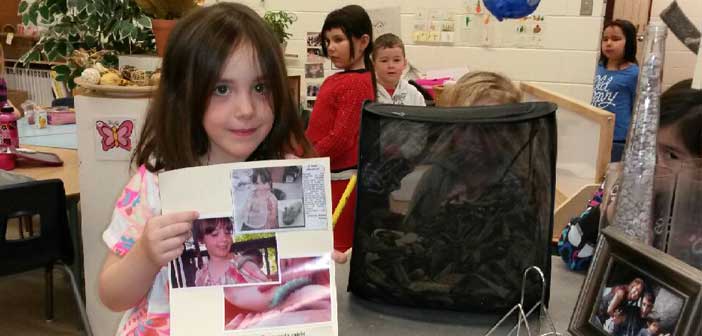LITTLE CURRENT—The Kindergarten students of Ms. Volpini’s Little Current Public School class were greeted with a special guest this past Monday morning. Classmate Georgia Roy’s cecropia chrysalis, which she first discovered as a bright green caterpillar last fall, emerged over the weekend as a full-fledged cecropia moth.
Georgia’s mother, Amanda Roy, explained that as she and little brother Joey were walking Georgia to class on Monday morning they were met by Georgia’s grandfather, Cliff Jewell, chief custodian at the school, and Ms. Volpini, who were both eager to share the news of the giant moth.
Last year The Expositor shared a photo of Georgia’s find, which also garnered the attention of Dr. Joseph Shorthouse, a Laurentian University professor of entomology, who told the family, through a letter to the editor, the steps of how to keep the chrysalis over the winter months.
Georgia and her family had the opportunity to watch the cecropia spin its cocoon and enter the chrysalis phase. On the advice of Dr. Shorthouse, the Roy family placed the chrysalis (and a few sticks and leaves for comfort) in a mesh butterfly trap and placed it in the porch where it would be sheltered from the elements but receive the cold it needed to advance to the adult stage. He advised the Roys to bring the pupa inside in late February or early March to, hopefully, be rewarded with a beautiful moth.

Ms. Roy explained that the decision was made, based on the extended cold winter season, to wait until two weeks ago before bringing the moth indoors and into Georgia’s classroom—a decision that paid off.
Sadly, the beautiful moth, North America’s largest moth, only has about a two-week lifespan following its emergence. The moth’s sole purpose in life is reproduction and does not have functional mouthparts or a digestive system. According to one online article, to find a mate, the female cecropia moth emits pheromones that the male’s sensitive antennae can detect up to a mile away, although a male may fly up to seven miles while searching for a female. Mating begins in the early morning hours and lasts until the evening. Afterward the female lays up to one hundred eggs, which hatch into tiny black caterpillars. The moth then dies.
The class is still debating when they will let the moth go, as the weather was not conducive to flying earlier this week but will likely be sometime soon as time is precious for the cecropia.




